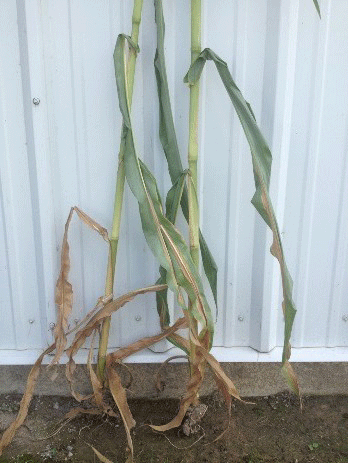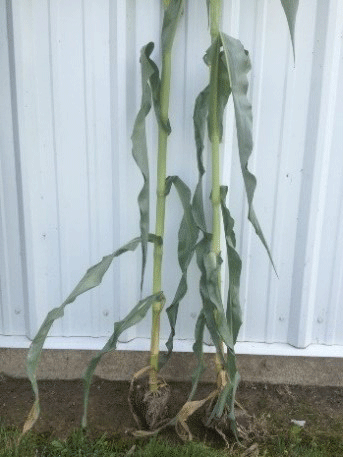Evaluating late-season N
FIELD TRIALS OF LATE N APPS SHOW PROMISE
FARMERS?HAVE?LONG recognized the importance of nitrogen to achieve higher yields, and now, with precision agriculture there are more options to consider when applying this costly and highly soluble nutrient to your crops.
PHOTO A: TYPICAL SIDEDRESS WE HAVE USED FOR THE PAST FEW YEARS.
• 12 gal/acre 28% applied at planting (April 29th)
• 50 gal/acre 28% sidedress with coulter cart at V5 – V6 (May 28th)

PHOTO B: LATE SEASON RECOMMENDATION
• 12 gal/acre 28% applied at planting (April 29th)
• 30 gal/acre 28% sidedress with coulter cart at V5 – V6 (May 28th)
• 60 gal/acre 28% applied with Y-Drops at V10 – 11 (July 5th) Rate recommended by 360 SoilScan

Late season application is at the forefront of options to consider when managing nitrogen. The theory behind late season nitrogen application is that a plant’s demand is highest during its later stages of vegetative growth. Applying one hundred percent of nitrogen earlier in the season increases risk of loss due to volatilization, denitrification, leaching, and soil displacement before the plant can utilize it.
Applying a portion of nitrogen later in the season, even up to tassel, allows for availability when nitrogen applied conventionally may be depleted. Rates can be decided based on expected yield potential, existing organic matter in soil, and rainfall, — something that would be difficult to consider when applying everything on the front end. Late season application also extends the application window, an important attribute when field entry is delayed due to rainfall.
THE 2015 FIELD SET UP
Using the 360 Yield Center SoilScan and Y-DROP system, Devolder Farms has captured data across three different nitrogen application scenarios: traditional sidedress only, half the recommended rate split late application, and full late season recommendation. The results were quite dramatic.
Stalks stayed noticeably greener as nitrogen application was delayed, improving stalk health and plant standability longer into the season. A healthy corn stalk keeps capillary action open and aids in the movement of nutrients into the ear and also allows moisture to move out of the ear for dry down. We did not see any difference in moisture at harvest for the late season N in 2015 — this may be a result of the season. Even with the late season application of fungicide, there was no noticeable difference.
Yield was responsive but we will need to fine-tune our application to account for various soil types and the needs of the crop. The SoilScan should help with this in 2016.
Considering modern corn hybrids demand high levels of nitrogen after v10, the benefits of late season application are primarily seen in filling out of each individual kernel, as opposed to width or length of the ear which is determined at v4 and v6 respectively.
Another important aspect of late season nitrogen application is a wider window for application on years when entering the field is delayed because of rain fall.
USING Y-DROPS
The application methodology is quite simple. First, SoilScan, a portable nitrogen testing machine allows the grower or agronomist to test the soil right at the field, essentially turning a pick-up or four wheeler into a portable nitrogen testing lab. Test results are available within ten minutes. The recommended rate is subsequently applied using Y-DROP, a precision nitrogen placement upgrade for high clearance sprayers that drizzles nitrogen at the base of the stalk where it is absorbed using dew moisture or a light rainfall.
Late season nitrogen application provides a dose of nitrogen when the plant can readily use it; uptake is not as dependent on a significant rainfall event, reducing the risk of run off. Nitrogen leaching is a concern especially on lighter soils with low cation exchange capacities and volatization is a concern in standing water.
There are many factors to consider when determining the most beneficial nitrogen management techniques to apply on your farm. As the agricultural industry faces increased environmental scrutiny, precision nitrogen management is a preemptive way to address the trend of increased regulations while taking advantage of increased yield potential. •







